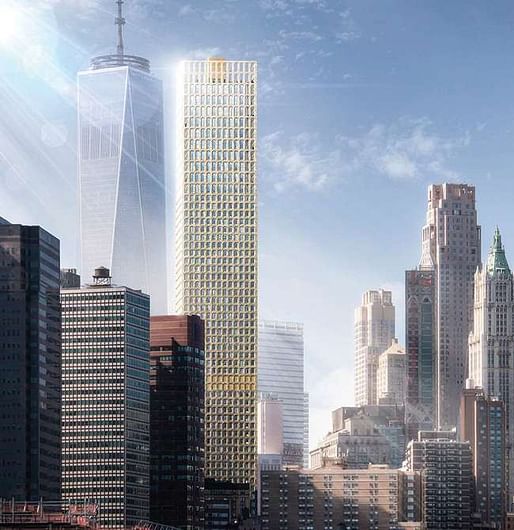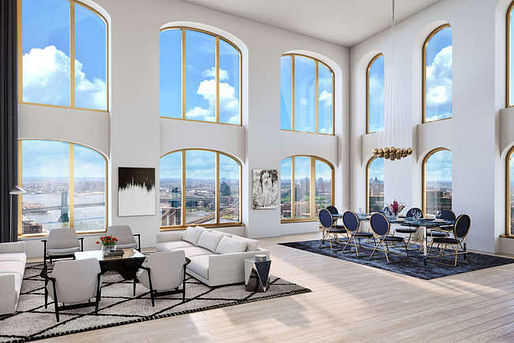
When it opens in 2019, the building is expected to be one of the tallest in the neighborhood. Views from the skyscraper include the Statue of Liberty, the Woolworth Building, City Hall Park and the East River. The condos will range from $630,000 studios to $4.7 million four-bedrooms. — 6sqft
Three years ago, starchitect David Adjaye completed his first project in NYC, an affordable housing complex in Harlem called the Sugar Hill Development.


Now that he's garnered international fame for his National Museum of African American History and Culture in DC, Adjaye is coming back to the big apple to build his first skyscraper in the city-- a 61-story, 750-foot-tall condominium condo in the Financial District. Known as the Wall Street Tower, it appears as a gold prism against rigid rows of arched windows.
23 Comments
seems boring
<gag>
But the stupid rich will love it. It's gold!
Disappointing ....stick to cultural institutions.not institutions for the wealthy and vain whom Sir David used to fight against
Don't get wrong .i love David and his work (even have his book) but this one is below par.
what tha fuck!
There is an entire new crop of low achieving condo projects designed by high achieving firms. Does anyone know if the NY Times still has an Architecture critic?
Annabelle Selldorf, 347 Bowery
Herzog & de Meuron, 215 Chrystie Street
Herzog & de Meuron, 160 Leroy
OMA, 121 E22nd

David Chipperfield, 16 West 40th

i agree, i think NArchitect's micro-unit tower and BIG's west 8th project are the only interesting tall buildings in the city the past couple years.
All anti-humanist luxury condos for the elite. None of them have any cultural value. That being said, Seldorf's is the only one with any aesthetic value.
Does every building have to have cultural value? While not great architecture, these actually aren't bad background buildings from a larger urban perspective.
Sorry, wrong word. Should have said SOCIAL value. These buildings are a perfect reflection of CULTURAL values, which is why they exist.
Every building has some cultural value. If you're looking at a building, living in it, working in it, then its not "background." These buildings are not going to be ignored. They're going to be seen... seen as mediocre works by firms that are capable of much more.
davvid, kinda seems like you are just arguing to be argumentative, but from the photos you posted above, how can you assess the quality of "living" or "working" in those buildings? They're just renderings from a totally detached viewpoint. And while perhaps architecturally pretty banal, I see nothing in them that would have a negative impact on public space (as opposed to many other more vanity-driven projects). Seems like you are going out of your way to be negative.
You introduced the term "background buildings" and my point is that there is no such thing as a background building.
For the vast majority of people who experience a City, most buildings are background buildings including these regardless of the pedigree of the design firm. The renderings you posted show them as background buildings within an urban context. But whatevs, dude... not worth arguing.
You're just not getting it because you're not trying to get it. "Background" and "foreground" are relative to the position of the viewer. It is always a matter of perception. Understand? All the people you pass on the street without thinking are "background" people. All the books you didn't read are "background" books. This is why setting out to design a "background" or "foreground" building is a supremely flawed approach to design. But my guess is that these firms didn't actually set out to design a "background" building. They probably recognized that these buildings are pieces of luxury real estate more than they are opportunities to push cultural/aesthetic boundaries. The capitalist context probably favored conformity so that the property could appeal to a broader range of potential buyers. These buildings reflect the banality of mass luxury.
davvid, kinda seems like you are just arguing to be argumentative. Who was setting out to design a "background" or "foreground" building?
"Who was setting out to design a "background" or "foreground" building?"
Ask won and done williams.
I'm not saying anyone set out to design a background building. I'm just saying that is what they are. Sorry I brought it up.
One of the best professors I had the privilege of studying with used to extoll the virtues of "background" buildings, one such example was the Enso Gutzeit building by alvar Aalto. His use of the term "background" was not pagorative, rather it described a high quality design that exercised restraint and respect for context. Others might use the term "fabric" building. Not every building needs to make a spectacle of itself, most of the great urban areas are filled with such buildings. With that said, I'm not sure any of the buildings daavid posted rise to the level of good background buildings.
those cocky pseudo-tuscan archs, I hate them - they're usually under-framed on a perfectly square opening. But I guess we're living the era of "why not?".
More like the era of "fuck it"
this too shall pass, (at least that's my mantra in the mornings)
Block this user
Are you sure you want to block this user and hide all related comments throughout the site?
Archinect
This is your first comment on Archinect. Your comment will be visible once approved.